Employment Relations: Analysis of Australian Trade Unions
VerifiedAdded on 2021/04/17
|11
|2817
|22
Essay
AI Summary
This essay delves into the complexities of employment relations in Australia, with a particular focus on the Australian Council of Trade Unions (ACTU) and its influence. It examines the ACTU's objectives, including managing wages, improving working conditions, and advocating for worker rights. The essay explores the historical context of union membership, highlighting the decline in recent decades and its implications. It analyzes the impact of trade unions on the labor market, including their effects on wages, discrimination, and productivity, considering both positive and negative aspects. The analysis includes the views of various stakeholders, such as the Australian Chamber of Commerce and Industry, and examines the challenges and opportunities facing unions in the current environment. The essay concludes with recommendations for the future of trade unions in Australia, emphasizing the need for adaptation and a renewed focus on worker solidarity and the importance of addressing the changing dynamics of the labor market.
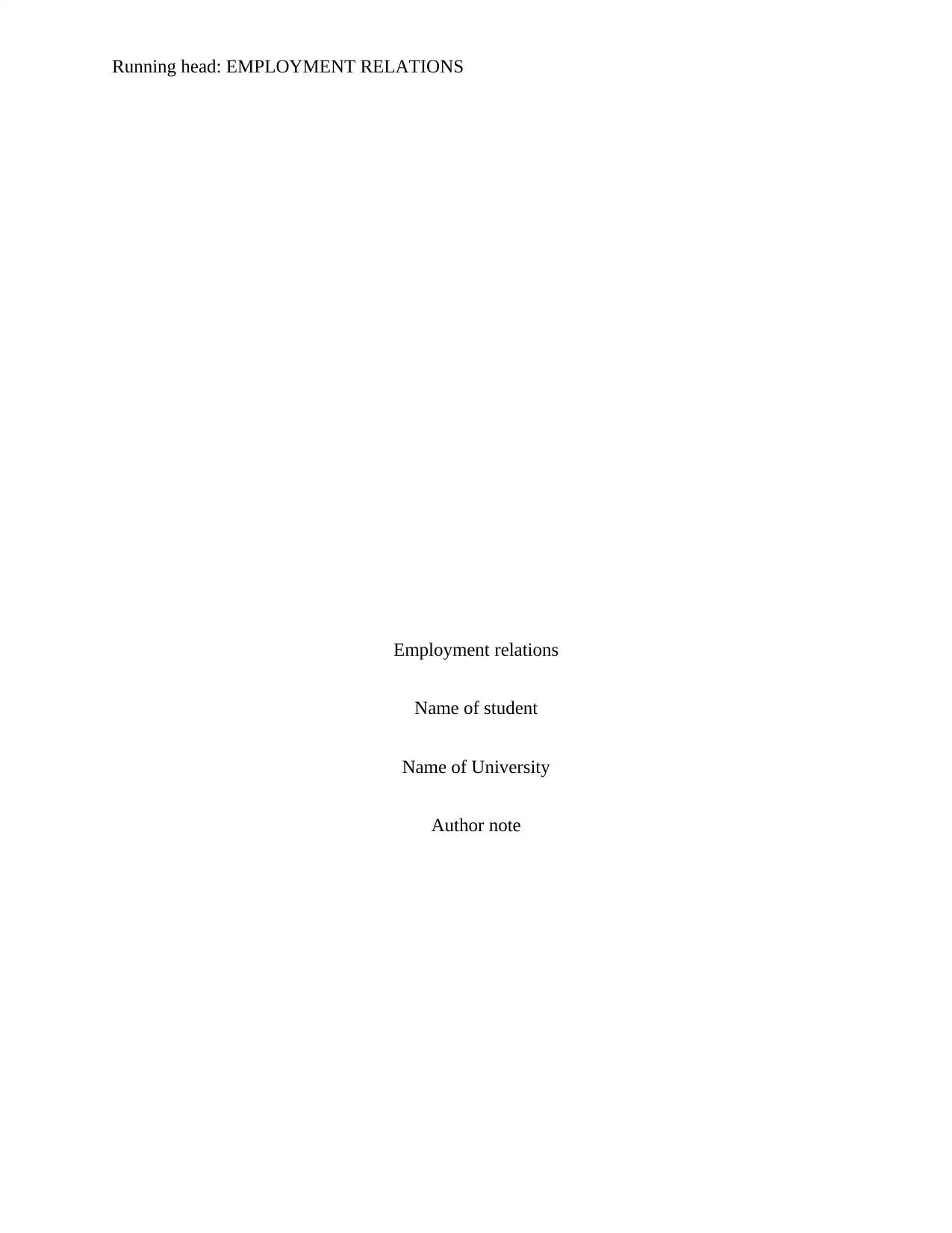
Running head: EMPLOYMENT RELATIONS
Employment relations
Name of student
Name of University
Author note
Employment relations
Name of student
Name of University
Author note
Paraphrase This Document
Need a fresh take? Get an instant paraphrase of this document with our AI Paraphraser
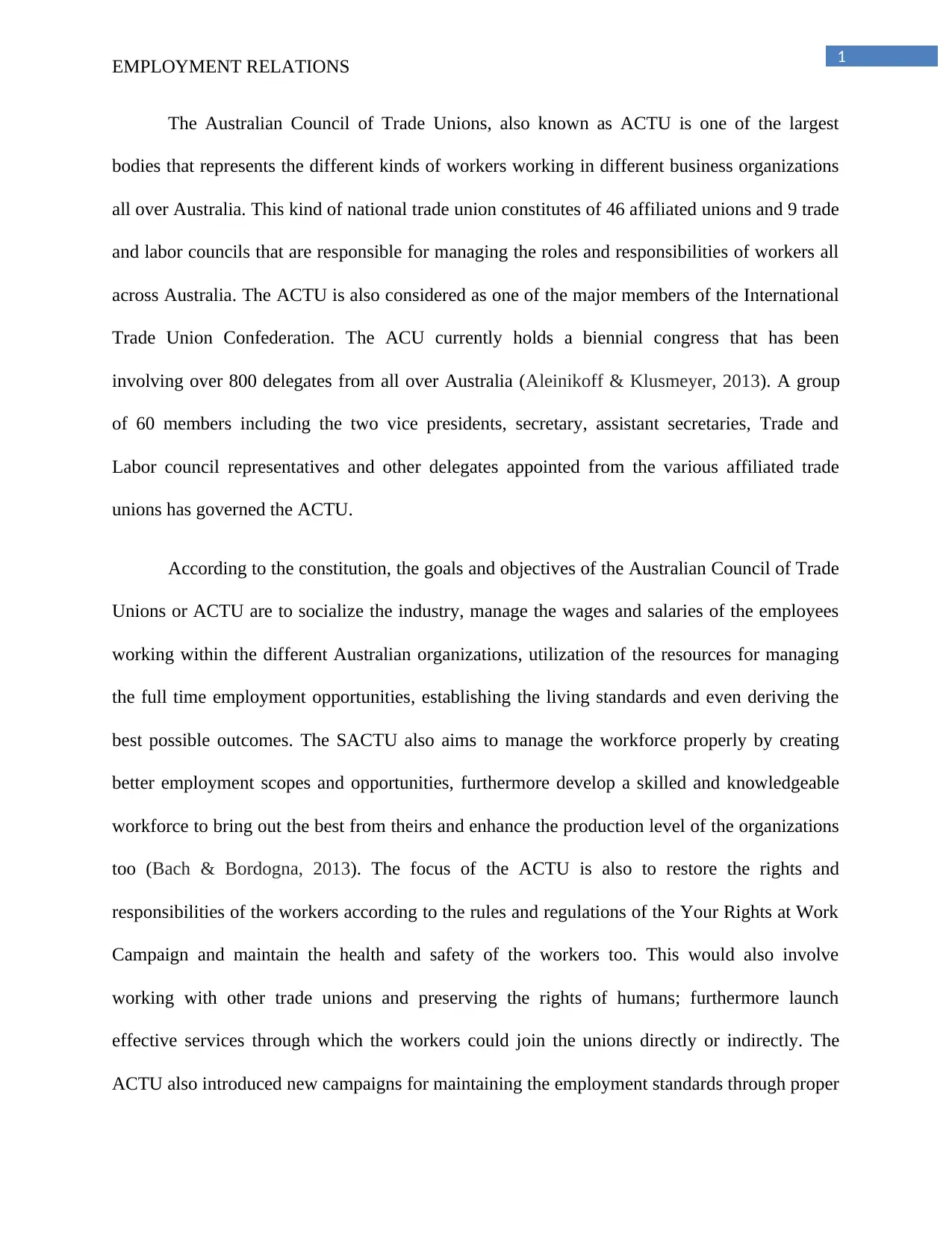
1
EMPLOYMENT RELATIONS
The Australian Council of Trade Unions, also known as ACTU is one of the largest
bodies that represents the different kinds of workers working in different business organizations
all over Australia. This kind of national trade union constitutes of 46 affiliated unions and 9 trade
and labor councils that are responsible for managing the roles and responsibilities of workers all
across Australia. The ACTU is also considered as one of the major members of the International
Trade Union Confederation. The ACU currently holds a biennial congress that has been
involving over 800 delegates from all over Australia (Aleinikoff & Klusmeyer, 2013). A group
of 60 members including the two vice presidents, secretary, assistant secretaries, Trade and
Labor council representatives and other delegates appointed from the various affiliated trade
unions has governed the ACTU.
According to the constitution, the goals and objectives of the Australian Council of Trade
Unions or ACTU are to socialize the industry, manage the wages and salaries of the employees
working within the different Australian organizations, utilization of the resources for managing
the full time employment opportunities, establishing the living standards and even deriving the
best possible outcomes. The SACTU also aims to manage the workforce properly by creating
better employment scopes and opportunities, furthermore develop a skilled and knowledgeable
workforce to bring out the best from theirs and enhance the production level of the organizations
too (Bach & Bordogna, 2013). The focus of the ACTU is also to restore the rights and
responsibilities of the workers according to the rules and regulations of the Your Rights at Work
Campaign and maintain the health and safety of the workers too. This would also involve
working with other trade unions and preserving the rights of humans; furthermore launch
effective services through which the workers could join the unions directly or indirectly. The
ACTU also introduced new campaigns for maintaining the employment standards through proper
EMPLOYMENT RELATIONS
The Australian Council of Trade Unions, also known as ACTU is one of the largest
bodies that represents the different kinds of workers working in different business organizations
all over Australia. This kind of national trade union constitutes of 46 affiliated unions and 9 trade
and labor councils that are responsible for managing the roles and responsibilities of workers all
across Australia. The ACTU is also considered as one of the major members of the International
Trade Union Confederation. The ACU currently holds a biennial congress that has been
involving over 800 delegates from all over Australia (Aleinikoff & Klusmeyer, 2013). A group
of 60 members including the two vice presidents, secretary, assistant secretaries, Trade and
Labor council representatives and other delegates appointed from the various affiliated trade
unions has governed the ACTU.
According to the constitution, the goals and objectives of the Australian Council of Trade
Unions or ACTU are to socialize the industry, manage the wages and salaries of the employees
working within the different Australian organizations, utilization of the resources for managing
the full time employment opportunities, establishing the living standards and even deriving the
best possible outcomes. The SACTU also aims to manage the workforce properly by creating
better employment scopes and opportunities, furthermore develop a skilled and knowledgeable
workforce to bring out the best from theirs and enhance the production level of the organizations
too (Bach & Bordogna, 2013). The focus of the ACTU is also to restore the rights and
responsibilities of the workers according to the rules and regulations of the Your Rights at Work
Campaign and maintain the health and safety of the workers too. This would also involve
working with other trade unions and preserving the rights of humans; furthermore launch
effective services through which the workers could join the unions directly or indirectly. The
ACTU also introduced new campaigns for maintaining the employment standards through proper
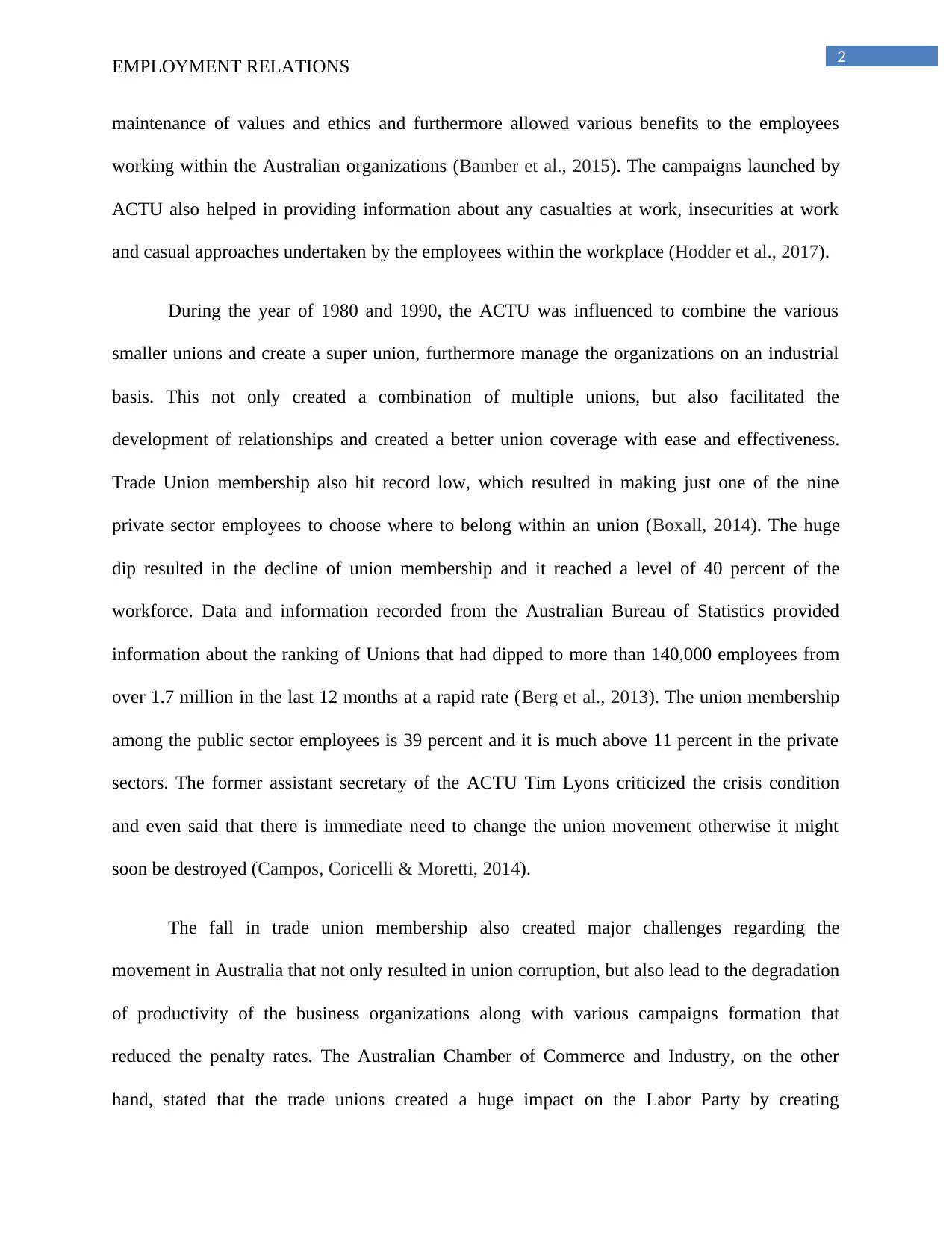
2
EMPLOYMENT RELATIONS
maintenance of values and ethics and furthermore allowed various benefits to the employees
working within the Australian organizations (Bamber et al., 2015). The campaigns launched by
ACTU also helped in providing information about any casualties at work, insecurities at work
and casual approaches undertaken by the employees within the workplace (Hodder et al., 2017).
During the year of 1980 and 1990, the ACTU was influenced to combine the various
smaller unions and create a super union, furthermore manage the organizations on an industrial
basis. This not only created a combination of multiple unions, but also facilitated the
development of relationships and created a better union coverage with ease and effectiveness.
Trade Union membership also hit record low, which resulted in making just one of the nine
private sector employees to choose where to belong within an union (Boxall, 2014). The huge
dip resulted in the decline of union membership and it reached a level of 40 percent of the
workforce. Data and information recorded from the Australian Bureau of Statistics provided
information about the ranking of Unions that had dipped to more than 140,000 employees from
over 1.7 million in the last 12 months at a rapid rate (Berg et al., 2013). The union membership
among the public sector employees is 39 percent and it is much above 11 percent in the private
sectors. The former assistant secretary of the ACTU Tim Lyons criticized the crisis condition
and even said that there is immediate need to change the union movement otherwise it might
soon be destroyed (Campos, Coricelli & Moretti, 2014).
The fall in trade union membership also created major challenges regarding the
movement in Australia that not only resulted in union corruption, but also lead to the degradation
of productivity of the business organizations along with various campaigns formation that
reduced the penalty rates. The Australian Chamber of Commerce and Industry, on the other
hand, stated that the trade unions created a huge impact on the Labor Party by creating
EMPLOYMENT RELATIONS
maintenance of values and ethics and furthermore allowed various benefits to the employees
working within the Australian organizations (Bamber et al., 2015). The campaigns launched by
ACTU also helped in providing information about any casualties at work, insecurities at work
and casual approaches undertaken by the employees within the workplace (Hodder et al., 2017).
During the year of 1980 and 1990, the ACTU was influenced to combine the various
smaller unions and create a super union, furthermore manage the organizations on an industrial
basis. This not only created a combination of multiple unions, but also facilitated the
development of relationships and created a better union coverage with ease and effectiveness.
Trade Union membership also hit record low, which resulted in making just one of the nine
private sector employees to choose where to belong within an union (Boxall, 2014). The huge
dip resulted in the decline of union membership and it reached a level of 40 percent of the
workforce. Data and information recorded from the Australian Bureau of Statistics provided
information about the ranking of Unions that had dipped to more than 140,000 employees from
over 1.7 million in the last 12 months at a rapid rate (Berg et al., 2013). The union membership
among the public sector employees is 39 percent and it is much above 11 percent in the private
sectors. The former assistant secretary of the ACTU Tim Lyons criticized the crisis condition
and even said that there is immediate need to change the union movement otherwise it might
soon be destroyed (Campos, Coricelli & Moretti, 2014).
The fall in trade union membership also created major challenges regarding the
movement in Australia that not only resulted in union corruption, but also lead to the degradation
of productivity of the business organizations along with various campaigns formation that
reduced the penalty rates. The Australian Chamber of Commerce and Industry, on the other
hand, stated that the trade unions created a huge impact on the Labor Party by creating
⊘ This is a preview!⊘
Do you want full access?
Subscribe today to unlock all pages.

Trusted by 1+ million students worldwide
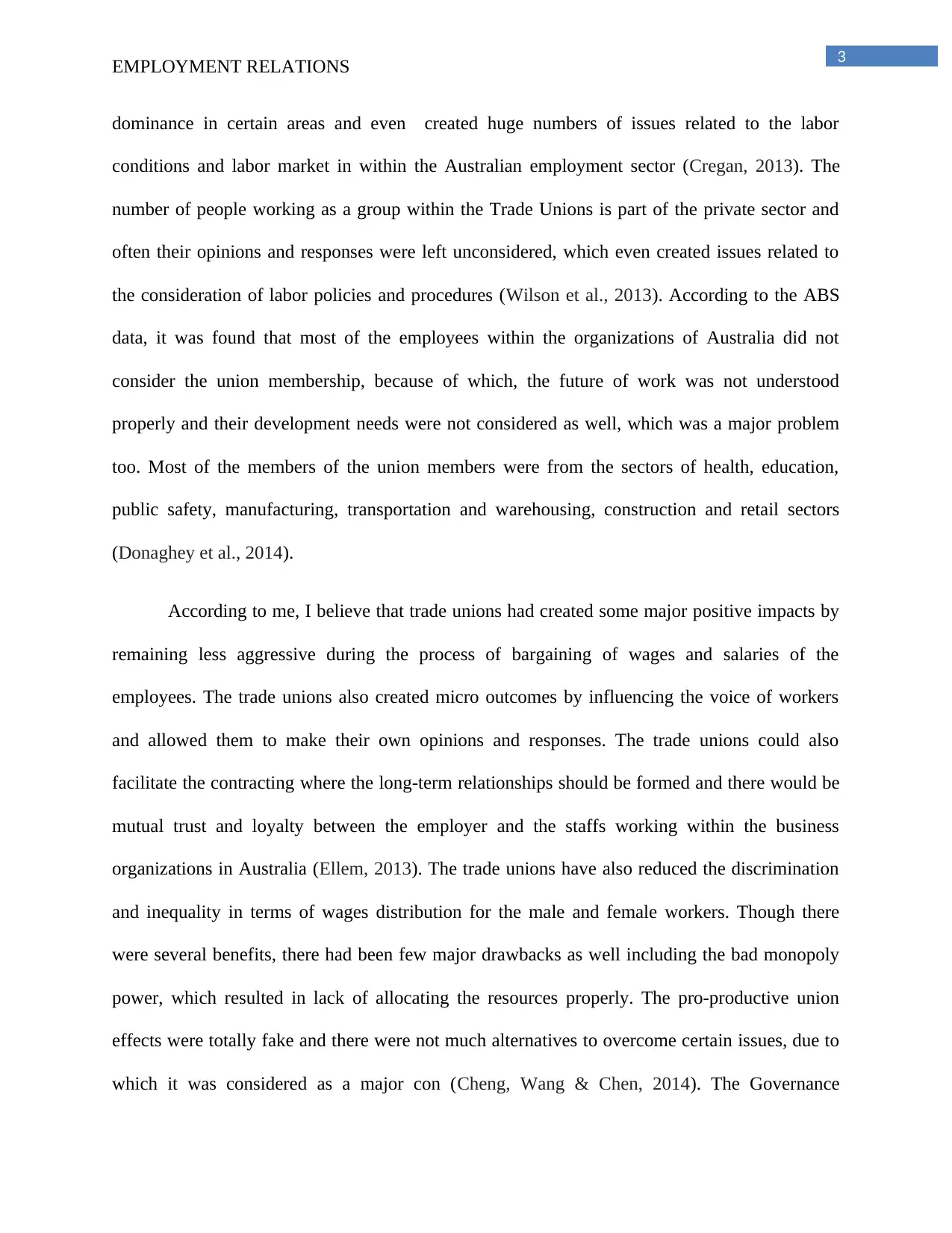
3
EMPLOYMENT RELATIONS
dominance in certain areas and even created huge numbers of issues related to the labor
conditions and labor market in within the Australian employment sector (Cregan, 2013). The
number of people working as a group within the Trade Unions is part of the private sector and
often their opinions and responses were left unconsidered, which even created issues related to
the consideration of labor policies and procedures (Wilson et al., 2013). According to the ABS
data, it was found that most of the employees within the organizations of Australia did not
consider the union membership, because of which, the future of work was not understood
properly and their development needs were not considered as well, which was a major problem
too. Most of the members of the union members were from the sectors of health, education,
public safety, manufacturing, transportation and warehousing, construction and retail sectors
(Donaghey et al., 2014).
According to me, I believe that trade unions had created some major positive impacts by
remaining less aggressive during the process of bargaining of wages and salaries of the
employees. The trade unions also created micro outcomes by influencing the voice of workers
and allowed them to make their own opinions and responses. The trade unions could also
facilitate the contracting where the long-term relationships should be formed and there would be
mutual trust and loyalty between the employer and the staffs working within the business
organizations in Australia (Ellem, 2013). The trade unions have also reduced the discrimination
and inequality in terms of wages distribution for the male and female workers. Though there
were several benefits, there had been few major drawbacks as well including the bad monopoly
power, which resulted in lack of allocating the resources properly. The pro-productive union
effects were totally fake and there were not much alternatives to overcome certain issues, due to
which it was considered as a major con (Cheng, Wang & Chen, 2014). The Governance
EMPLOYMENT RELATIONS
dominance in certain areas and even created huge numbers of issues related to the labor
conditions and labor market in within the Australian employment sector (Cregan, 2013). The
number of people working as a group within the Trade Unions is part of the private sector and
often their opinions and responses were left unconsidered, which even created issues related to
the consideration of labor policies and procedures (Wilson et al., 2013). According to the ABS
data, it was found that most of the employees within the organizations of Australia did not
consider the union membership, because of which, the future of work was not understood
properly and their development needs were not considered as well, which was a major problem
too. Most of the members of the union members were from the sectors of health, education,
public safety, manufacturing, transportation and warehousing, construction and retail sectors
(Donaghey et al., 2014).
According to me, I believe that trade unions had created some major positive impacts by
remaining less aggressive during the process of bargaining of wages and salaries of the
employees. The trade unions also created micro outcomes by influencing the voice of workers
and allowed them to make their own opinions and responses. The trade unions could also
facilitate the contracting where the long-term relationships should be formed and there would be
mutual trust and loyalty between the employer and the staffs working within the business
organizations in Australia (Ellem, 2013). The trade unions have also reduced the discrimination
and inequality in terms of wages distribution for the male and female workers. Though there
were several benefits, there had been few major drawbacks as well including the bad monopoly
power, which resulted in lack of allocating the resources properly. The pro-productive union
effects were totally fake and there were not much alternatives to overcome certain issues, due to
which it was considered as a major con (Cheng, Wang & Chen, 2014). The Governance
Paraphrase This Document
Need a fresh take? Get an instant paraphrase of this document with our AI Paraphraser
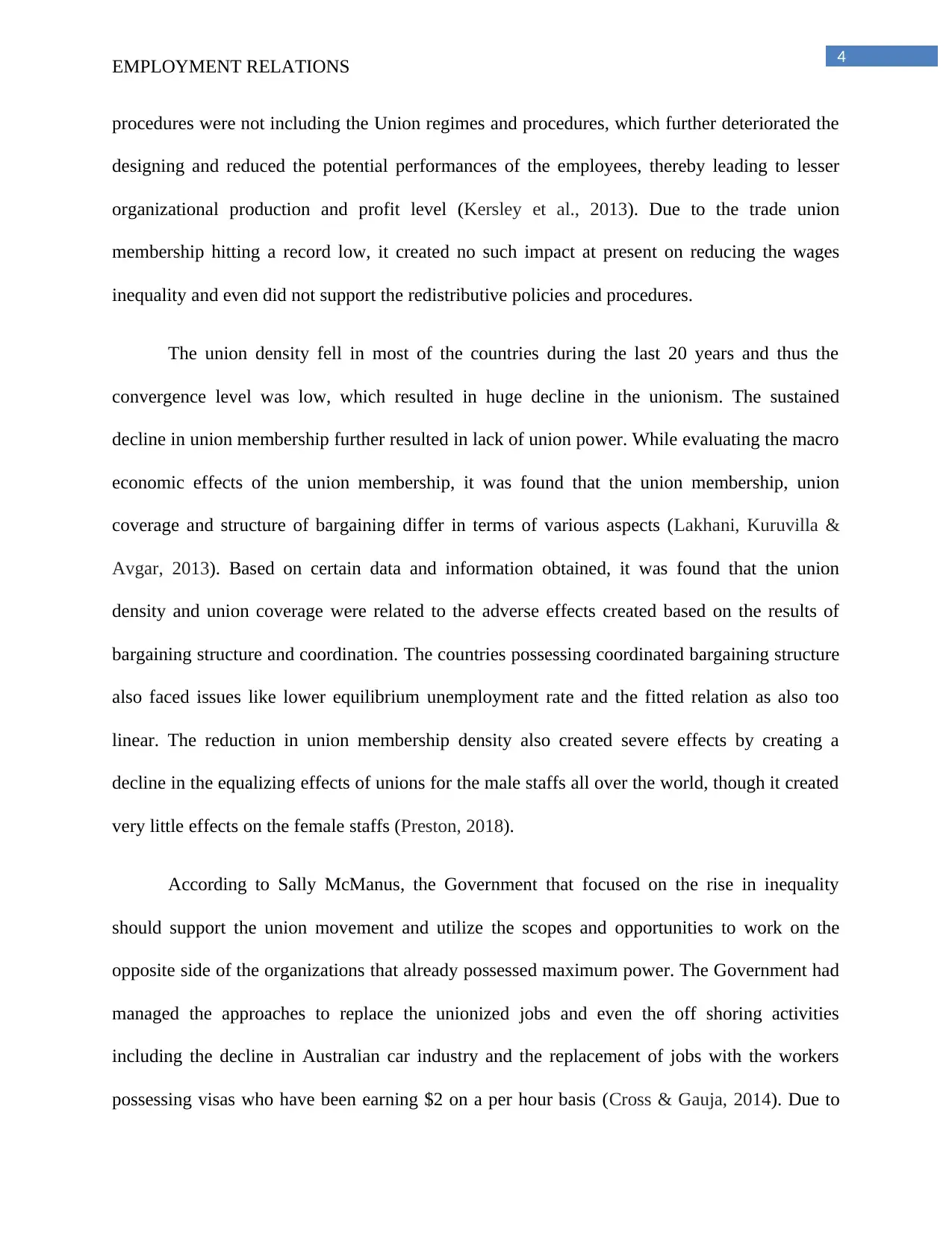
4
EMPLOYMENT RELATIONS
procedures were not including the Union regimes and procedures, which further deteriorated the
designing and reduced the potential performances of the employees, thereby leading to lesser
organizational production and profit level (Kersley et al., 2013). Due to the trade union
membership hitting a record low, it created no such impact at present on reducing the wages
inequality and even did not support the redistributive policies and procedures.
The union density fell in most of the countries during the last 20 years and thus the
convergence level was low, which resulted in huge decline in the unionism. The sustained
decline in union membership further resulted in lack of union power. While evaluating the macro
economic effects of the union membership, it was found that the union membership, union
coverage and structure of bargaining differ in terms of various aspects (Lakhani, Kuruvilla &
Avgar, 2013). Based on certain data and information obtained, it was found that the union
density and union coverage were related to the adverse effects created based on the results of
bargaining structure and coordination. The countries possessing coordinated bargaining structure
also faced issues like lower equilibrium unemployment rate and the fitted relation as also too
linear. The reduction in union membership density also created severe effects by creating a
decline in the equalizing effects of unions for the male staffs all over the world, though it created
very little effects on the female staffs (Preston, 2018).
According to Sally McManus, the Government that focused on the rise in inequality
should support the union movement and utilize the scopes and opportunities to work on the
opposite side of the organizations that already possessed maximum power. The Government had
managed the approaches to replace the unionized jobs and even the off shoring activities
including the decline in Australian car industry and the replacement of jobs with the workers
possessing visas who have been earning $2 on a per hour basis (Cross & Gauja, 2014). Due to
EMPLOYMENT RELATIONS
procedures were not including the Union regimes and procedures, which further deteriorated the
designing and reduced the potential performances of the employees, thereby leading to lesser
organizational production and profit level (Kersley et al., 2013). Due to the trade union
membership hitting a record low, it created no such impact at present on reducing the wages
inequality and even did not support the redistributive policies and procedures.
The union density fell in most of the countries during the last 20 years and thus the
convergence level was low, which resulted in huge decline in the unionism. The sustained
decline in union membership further resulted in lack of union power. While evaluating the macro
economic effects of the union membership, it was found that the union membership, union
coverage and structure of bargaining differ in terms of various aspects (Lakhani, Kuruvilla &
Avgar, 2013). Based on certain data and information obtained, it was found that the union
density and union coverage were related to the adverse effects created based on the results of
bargaining structure and coordination. The countries possessing coordinated bargaining structure
also faced issues like lower equilibrium unemployment rate and the fitted relation as also too
linear. The reduction in union membership density also created severe effects by creating a
decline in the equalizing effects of unions for the male staffs all over the world, though it created
very little effects on the female staffs (Preston, 2018).
According to Sally McManus, the Government that focused on the rise in inequality
should support the union movement and utilize the scopes and opportunities to work on the
opposite side of the organizations that already possessed maximum power. The Government had
managed the approaches to replace the unionized jobs and even the off shoring activities
including the decline in Australian car industry and the replacement of jobs with the workers
possessing visas who have been earning $2 on a per hour basis (Cross & Gauja, 2014). Due to
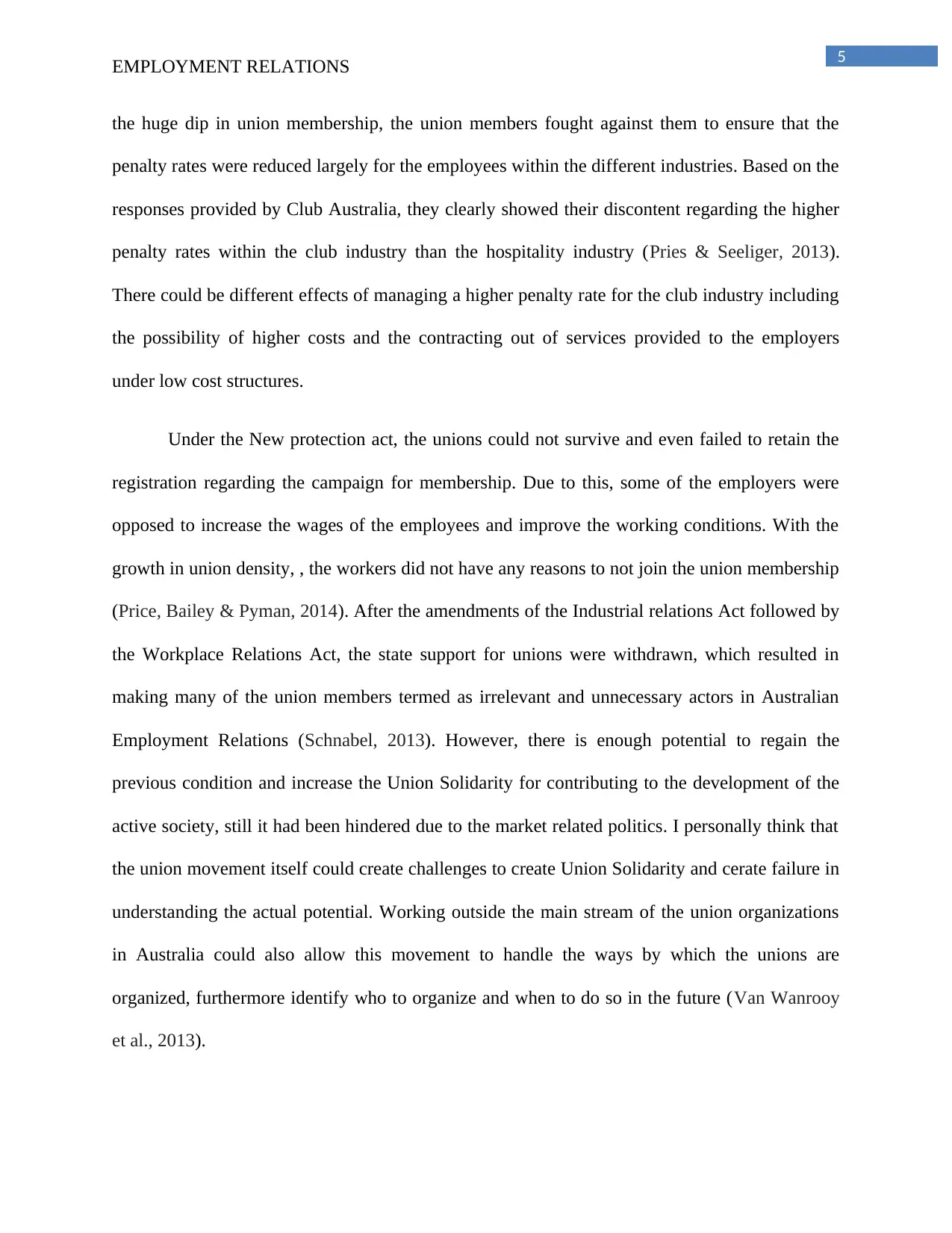
5
EMPLOYMENT RELATIONS
the huge dip in union membership, the union members fought against them to ensure that the
penalty rates were reduced largely for the employees within the different industries. Based on the
responses provided by Club Australia, they clearly showed their discontent regarding the higher
penalty rates within the club industry than the hospitality industry (Pries & Seeliger, 2013).
There could be different effects of managing a higher penalty rate for the club industry including
the possibility of higher costs and the contracting out of services provided to the employers
under low cost structures.
Under the New protection act, the unions could not survive and even failed to retain the
registration regarding the campaign for membership. Due to this, some of the employers were
opposed to increase the wages of the employees and improve the working conditions. With the
growth in union density, , the workers did not have any reasons to not join the union membership
(Price, Bailey & Pyman, 2014). After the amendments of the Industrial relations Act followed by
the Workplace Relations Act, the state support for unions were withdrawn, which resulted in
making many of the union members termed as irrelevant and unnecessary actors in Australian
Employment Relations (Schnabel, 2013). However, there is enough potential to regain the
previous condition and increase the Union Solidarity for contributing to the development of the
active society, still it had been hindered due to the market related politics. I personally think that
the union movement itself could create challenges to create Union Solidarity and cerate failure in
understanding the actual potential. Working outside the main stream of the union organizations
in Australia could also allow this movement to handle the ways by which the unions are
organized, furthermore identify who to organize and when to do so in the future (Van Wanrooy
et al., 2013).
EMPLOYMENT RELATIONS
the huge dip in union membership, the union members fought against them to ensure that the
penalty rates were reduced largely for the employees within the different industries. Based on the
responses provided by Club Australia, they clearly showed their discontent regarding the higher
penalty rates within the club industry than the hospitality industry (Pries & Seeliger, 2013).
There could be different effects of managing a higher penalty rate for the club industry including
the possibility of higher costs and the contracting out of services provided to the employers
under low cost structures.
Under the New protection act, the unions could not survive and even failed to retain the
registration regarding the campaign for membership. Due to this, some of the employers were
opposed to increase the wages of the employees and improve the working conditions. With the
growth in union density, , the workers did not have any reasons to not join the union membership
(Price, Bailey & Pyman, 2014). After the amendments of the Industrial relations Act followed by
the Workplace Relations Act, the state support for unions were withdrawn, which resulted in
making many of the union members termed as irrelevant and unnecessary actors in Australian
Employment Relations (Schnabel, 2013). However, there is enough potential to regain the
previous condition and increase the Union Solidarity for contributing to the development of the
active society, still it had been hindered due to the market related politics. I personally think that
the union movement itself could create challenges to create Union Solidarity and cerate failure in
understanding the actual potential. Working outside the main stream of the union organizations
in Australia could also allow this movement to handle the ways by which the unions are
organized, furthermore identify who to organize and when to do so in the future (Van Wanrooy
et al., 2013).
⊘ This is a preview!⊘
Do you want full access?
Subscribe today to unlock all pages.

Trusted by 1+ million students worldwide
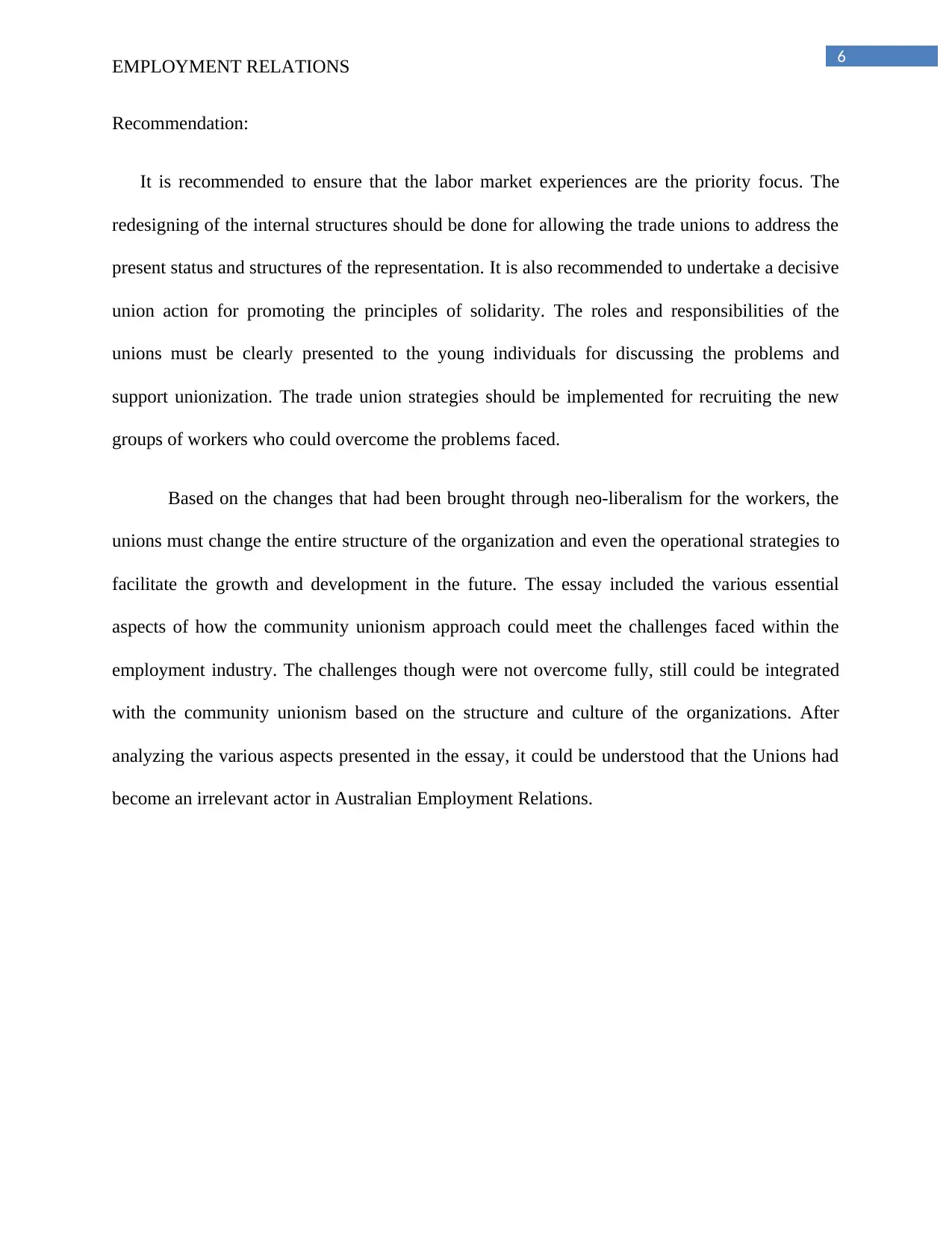
6
EMPLOYMENT RELATIONS
Recommendation:
It is recommended to ensure that the labor market experiences are the priority focus. The
redesigning of the internal structures should be done for allowing the trade unions to address the
present status and structures of the representation. It is also recommended to undertake a decisive
union action for promoting the principles of solidarity. The roles and responsibilities of the
unions must be clearly presented to the young individuals for discussing the problems and
support unionization. The trade union strategies should be implemented for recruiting the new
groups of workers who could overcome the problems faced.
Based on the changes that had been brought through neo-liberalism for the workers, the
unions must change the entire structure of the organization and even the operational strategies to
facilitate the growth and development in the future. The essay included the various essential
aspects of how the community unionism approach could meet the challenges faced within the
employment industry. The challenges though were not overcome fully, still could be integrated
with the community unionism based on the structure and culture of the organizations. After
analyzing the various aspects presented in the essay, it could be understood that the Unions had
become an irrelevant actor in Australian Employment Relations.
EMPLOYMENT RELATIONS
Recommendation:
It is recommended to ensure that the labor market experiences are the priority focus. The
redesigning of the internal structures should be done for allowing the trade unions to address the
present status and structures of the representation. It is also recommended to undertake a decisive
union action for promoting the principles of solidarity. The roles and responsibilities of the
unions must be clearly presented to the young individuals for discussing the problems and
support unionization. The trade union strategies should be implemented for recruiting the new
groups of workers who could overcome the problems faced.
Based on the changes that had been brought through neo-liberalism for the workers, the
unions must change the entire structure of the organization and even the operational strategies to
facilitate the growth and development in the future. The essay included the various essential
aspects of how the community unionism approach could meet the challenges faced within the
employment industry. The challenges though were not overcome fully, still could be integrated
with the community unionism based on the structure and culture of the organizations. After
analyzing the various aspects presented in the essay, it could be understood that the Unions had
become an irrelevant actor in Australian Employment Relations.
Paraphrase This Document
Need a fresh take? Get an instant paraphrase of this document with our AI Paraphraser
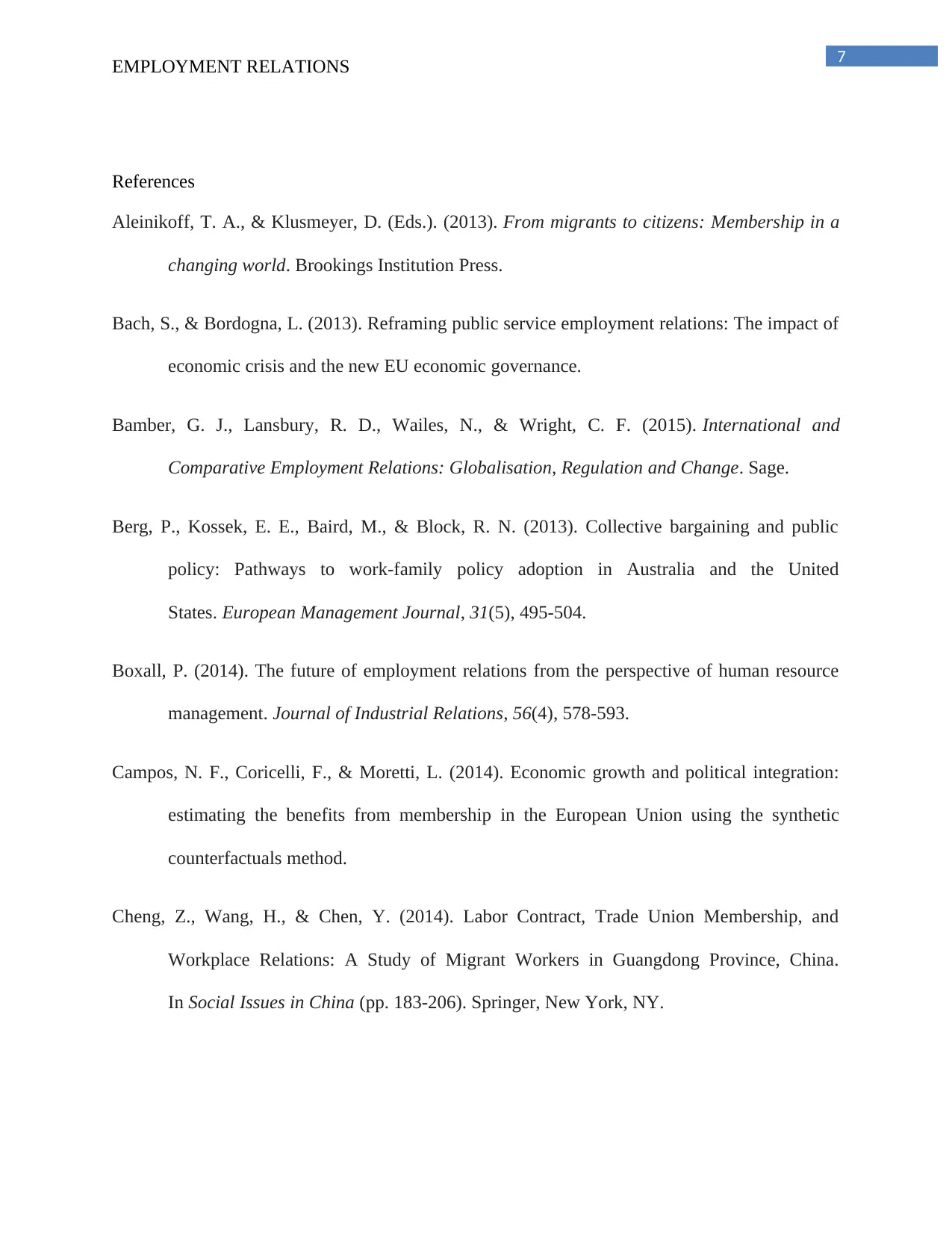
7
EMPLOYMENT RELATIONS
References
Aleinikoff, T. A., & Klusmeyer, D. (Eds.). (2013). From migrants to citizens: Membership in a
changing world. Brookings Institution Press.
Bach, S., & Bordogna, L. (2013). Reframing public service employment relations: The impact of
economic crisis and the new EU economic governance.
Bamber, G. J., Lansbury, R. D., Wailes, N., & Wright, C. F. (2015). International and
Comparative Employment Relations: Globalisation, Regulation and Change. Sage.
Berg, P., Kossek, E. E., Baird, M., & Block, R. N. (2013). Collective bargaining and public
policy: Pathways to work-family policy adoption in Australia and the United
States. European Management Journal, 31(5), 495-504.
Boxall, P. (2014). The future of employment relations from the perspective of human resource
management. Journal of Industrial Relations, 56(4), 578-593.
Campos, N. F., Coricelli, F., & Moretti, L. (2014). Economic growth and political integration:
estimating the benefits from membership in the European Union using the synthetic
counterfactuals method.
Cheng, Z., Wang, H., & Chen, Y. (2014). Labor Contract, Trade Union Membership, and
Workplace Relations: A Study of Migrant Workers in Guangdong Province, China.
In Social Issues in China (pp. 183-206). Springer, New York, NY.
EMPLOYMENT RELATIONS
References
Aleinikoff, T. A., & Klusmeyer, D. (Eds.). (2013). From migrants to citizens: Membership in a
changing world. Brookings Institution Press.
Bach, S., & Bordogna, L. (2013). Reframing public service employment relations: The impact of
economic crisis and the new EU economic governance.
Bamber, G. J., Lansbury, R. D., Wailes, N., & Wright, C. F. (2015). International and
Comparative Employment Relations: Globalisation, Regulation and Change. Sage.
Berg, P., Kossek, E. E., Baird, M., & Block, R. N. (2013). Collective bargaining and public
policy: Pathways to work-family policy adoption in Australia and the United
States. European Management Journal, 31(5), 495-504.
Boxall, P. (2014). The future of employment relations from the perspective of human resource
management. Journal of Industrial Relations, 56(4), 578-593.
Campos, N. F., Coricelli, F., & Moretti, L. (2014). Economic growth and political integration:
estimating the benefits from membership in the European Union using the synthetic
counterfactuals method.
Cheng, Z., Wang, H., & Chen, Y. (2014). Labor Contract, Trade Union Membership, and
Workplace Relations: A Study of Migrant Workers in Guangdong Province, China.
In Social Issues in China (pp. 183-206). Springer, New York, NY.
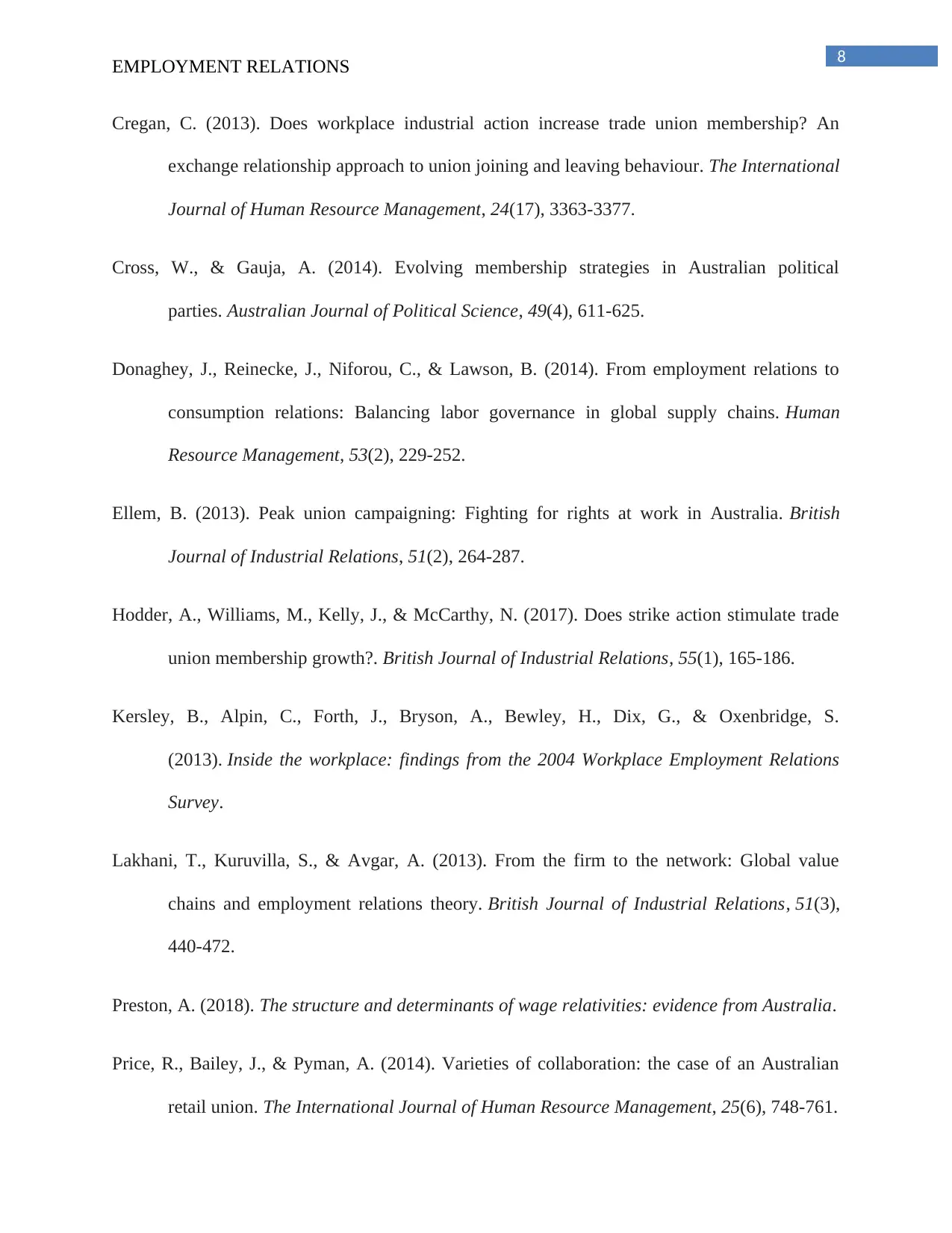
8
EMPLOYMENT RELATIONS
Cregan, C. (2013). Does workplace industrial action increase trade union membership? An
exchange relationship approach to union joining and leaving behaviour. The International
Journal of Human Resource Management, 24(17), 3363-3377.
Cross, W., & Gauja, A. (2014). Evolving membership strategies in Australian political
parties. Australian Journal of Political Science, 49(4), 611-625.
Donaghey, J., Reinecke, J., Niforou, C., & Lawson, B. (2014). From employment relations to
consumption relations: Balancing labor governance in global supply chains. Human
Resource Management, 53(2), 229-252.
Ellem, B. (2013). Peak union campaigning: Fighting for rights at work in Australia. British
Journal of Industrial Relations, 51(2), 264-287.
Hodder, A., Williams, M., Kelly, J., & McCarthy, N. (2017). Does strike action stimulate trade
union membership growth?. British Journal of Industrial Relations, 55(1), 165-186.
Kersley, B., Alpin, C., Forth, J., Bryson, A., Bewley, H., Dix, G., & Oxenbridge, S.
(2013). Inside the workplace: findings from the 2004 Workplace Employment Relations
Survey.
Lakhani, T., Kuruvilla, S., & Avgar, A. (2013). From the firm to the network: Global value
chains and employment relations theory. British Journal of Industrial Relations, 51(3),
440-472.
Preston, A. (2018). The structure and determinants of wage relativities: evidence from Australia.
Price, R., Bailey, J., & Pyman, A. (2014). Varieties of collaboration: the case of an Australian
retail union. The International Journal of Human Resource Management, 25(6), 748-761.
EMPLOYMENT RELATIONS
Cregan, C. (2013). Does workplace industrial action increase trade union membership? An
exchange relationship approach to union joining and leaving behaviour. The International
Journal of Human Resource Management, 24(17), 3363-3377.
Cross, W., & Gauja, A. (2014). Evolving membership strategies in Australian political
parties. Australian Journal of Political Science, 49(4), 611-625.
Donaghey, J., Reinecke, J., Niforou, C., & Lawson, B. (2014). From employment relations to
consumption relations: Balancing labor governance in global supply chains. Human
Resource Management, 53(2), 229-252.
Ellem, B. (2013). Peak union campaigning: Fighting for rights at work in Australia. British
Journal of Industrial Relations, 51(2), 264-287.
Hodder, A., Williams, M., Kelly, J., & McCarthy, N. (2017). Does strike action stimulate trade
union membership growth?. British Journal of Industrial Relations, 55(1), 165-186.
Kersley, B., Alpin, C., Forth, J., Bryson, A., Bewley, H., Dix, G., & Oxenbridge, S.
(2013). Inside the workplace: findings from the 2004 Workplace Employment Relations
Survey.
Lakhani, T., Kuruvilla, S., & Avgar, A. (2013). From the firm to the network: Global value
chains and employment relations theory. British Journal of Industrial Relations, 51(3),
440-472.
Preston, A. (2018). The structure and determinants of wage relativities: evidence from Australia.
Price, R., Bailey, J., & Pyman, A. (2014). Varieties of collaboration: the case of an Australian
retail union. The International Journal of Human Resource Management, 25(6), 748-761.
⊘ This is a preview!⊘
Do you want full access?
Subscribe today to unlock all pages.

Trusted by 1+ million students worldwide
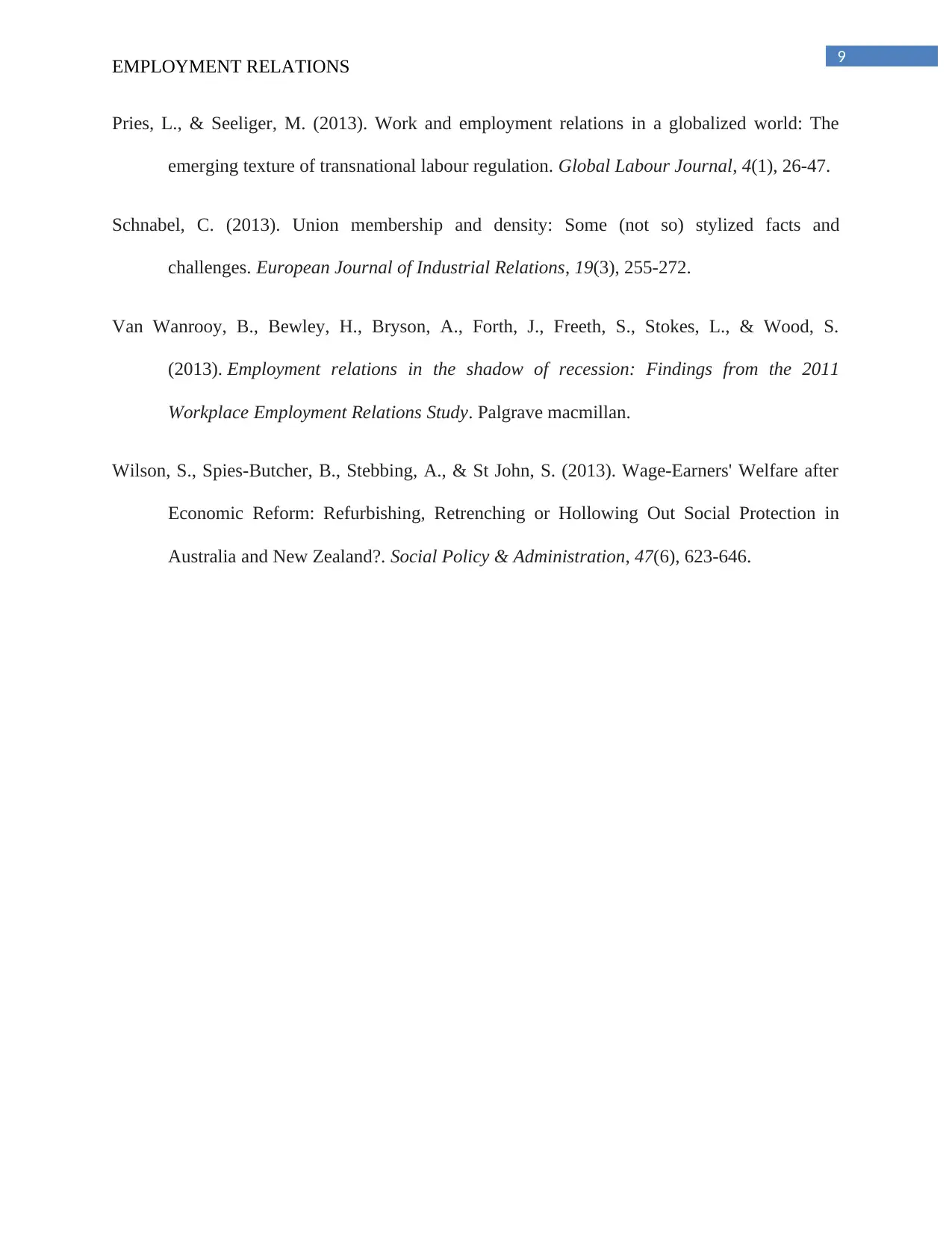
9
EMPLOYMENT RELATIONS
Pries, L., & Seeliger, M. (2013). Work and employment relations in a globalized world: The
emerging texture of transnational labour regulation. Global Labour Journal, 4(1), 26-47.
Schnabel, C. (2013). Union membership and density: Some (not so) stylized facts and
challenges. European Journal of Industrial Relations, 19(3), 255-272.
Van Wanrooy, B., Bewley, H., Bryson, A., Forth, J., Freeth, S., Stokes, L., & Wood, S.
(2013). Employment relations in the shadow of recession: Findings from the 2011
Workplace Employment Relations Study. Palgrave macmillan.
Wilson, S., Spies‐Butcher, B., Stebbing, A., & St John, S. (2013). Wage‐Earners' Welfare after
Economic Reform: Refurbishing, Retrenching or Hollowing Out Social Protection in
Australia and New Zealand?. Social Policy & Administration, 47(6), 623-646.
EMPLOYMENT RELATIONS
Pries, L., & Seeliger, M. (2013). Work and employment relations in a globalized world: The
emerging texture of transnational labour regulation. Global Labour Journal, 4(1), 26-47.
Schnabel, C. (2013). Union membership and density: Some (not so) stylized facts and
challenges. European Journal of Industrial Relations, 19(3), 255-272.
Van Wanrooy, B., Bewley, H., Bryson, A., Forth, J., Freeth, S., Stokes, L., & Wood, S.
(2013). Employment relations in the shadow of recession: Findings from the 2011
Workplace Employment Relations Study. Palgrave macmillan.
Wilson, S., Spies‐Butcher, B., Stebbing, A., & St John, S. (2013). Wage‐Earners' Welfare after
Economic Reform: Refurbishing, Retrenching or Hollowing Out Social Protection in
Australia and New Zealand?. Social Policy & Administration, 47(6), 623-646.
Paraphrase This Document
Need a fresh take? Get an instant paraphrase of this document with our AI Paraphraser

10
EMPLOYMENT RELATIONS
EMPLOYMENT RELATIONS
1 out of 11
Related Documents
Your All-in-One AI-Powered Toolkit for Academic Success.
+13062052269
info@desklib.com
Available 24*7 on WhatsApp / Email
![[object Object]](/_next/static/media/star-bottom.7253800d.svg)
Unlock your academic potential
Copyright © 2020–2025 A2Z Services. All Rights Reserved. Developed and managed by ZUCOL.





